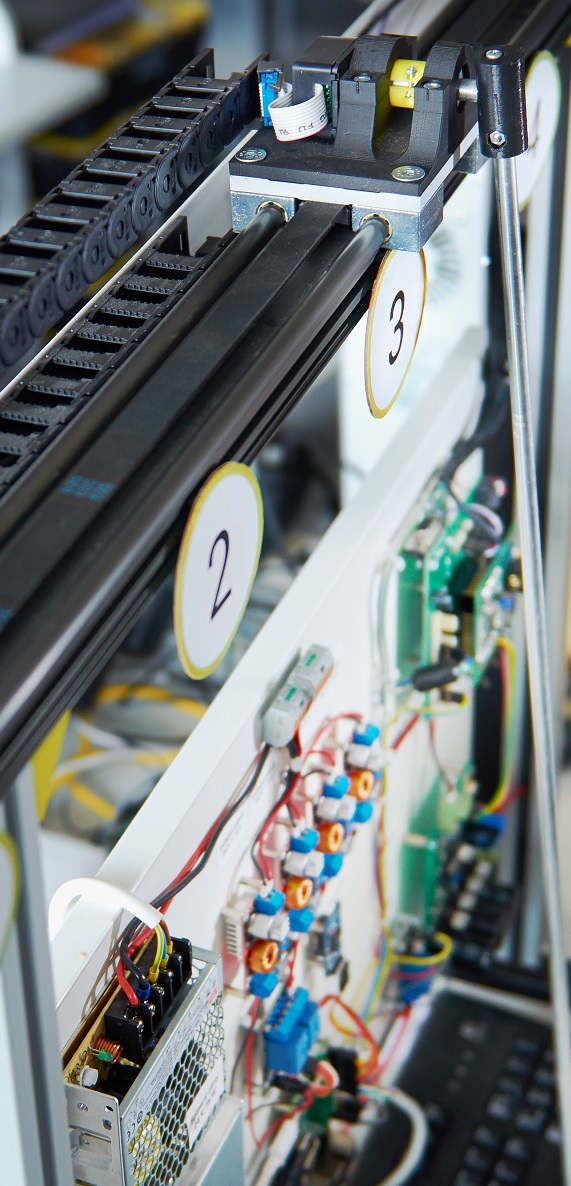Mechatronics, smart technology and virtual swins
The requirement of effective production and conservation of natural resources can be achieved by applied research and by the development of new technologies and their integration into modern machines, devices, and processes. A significant role is played be the development of mechatronic components and applications, which comprehensively covers the entire portfolio of mechatronics . These are in particular, innovation of mechanical elements, actuators and propulsions, including electronics, sensors, and specialised customer solutions. Another important area is the development and integration of smart technologies and materials into the design with the use of modern communication tools . Added value is then provided by the application of evaluating or decision-making software which is based on the methods of artificial intelligence. To achieve the required function of an integrated unit, it is necessary and effective to develop the whole complex of a smart component or a smart machine within the framework of one mechatronic platform . The application of the mechatronic approach is key in designing and the innovation of modern machinery (trial, testing and production machines, special electrical machines, industrial manipulators, individual smart solutions, modular and smart machines, etc.). The aim and advantage of this methodology is mainly the increase of utility parameters, comprehensiveness of the design, modularity, the increase of production efficiency, and energy saving.
The effective development of the mechatronic product is based on a multidisciplinary model/virtual prototype, on which the theoretical basis in the area of modelling and simulation methods of the behaviour of mechatronic systems is applied. The use of mechatronic approach and design leads to the required improvement of utility parameters with the maximal involvement of new materials and additive technologies. Further, these methods lead to a maximal efficiency in production and operation, and the creation of modular structure of components and machines. These aspects will find use particularly in smart machines and devices, special electric machines, production machines, and robotic facilities . Emphasis is placed on the application of modern methods of machining and engineering technology, and also on the integration of logistic and metallurgical processes.
This procedure makes possible not only the achievement in the increase of utility properties of smart components, but also to effectively develop electronic and hardware elements CPS to ensure the functionality of a specific smart solution. The key element in the development of smart machines is the integration of CPS and the sensored signals of a product together with a simulation model. A thus conceived functional unit, except custom smart solution, which can be displayed in a virtual environment, can also offer an additional functionality through a „virtual twin“.
The first generation of the virtual twin is a virtual prototype of a machine, which is conceived together with the design of the product and serves in production as a virtual prototype . In the creating process of the product, the twin develops, and because of verification tests and the integration of input from CPS, it reaches a match on a given differentiation level . Virtual twins can be classified also according to the reached differentiation level as a tool providing a combination of metadata, states, and operation conditions of the machine. The virtual twin can be effectively used for monitoring, analytical, decision-making, and optimisation tasks, which are related to the actual machine and thus create additional space for a smart solution of the product.
The potential of smart technology of virtual twin is based on the effective integration of electronic and hardware elements of CPS into the design of machines. CPS also integrate software tools for the pre-processing of the data and communication with cloud-storage. There is a mutual merge of the data with the simulation model of the virtual twin . During operation, the smart machine and its virtual twin offer the possibility of intelligent analysis of operation states, diagnostics, and in particular, the possibilities of predictive maintenance or even reconfiguration and self-repair. For predictive tasks of the behaviour and maintenance of the machine, the involvement of artificial intelligence is assumed.
